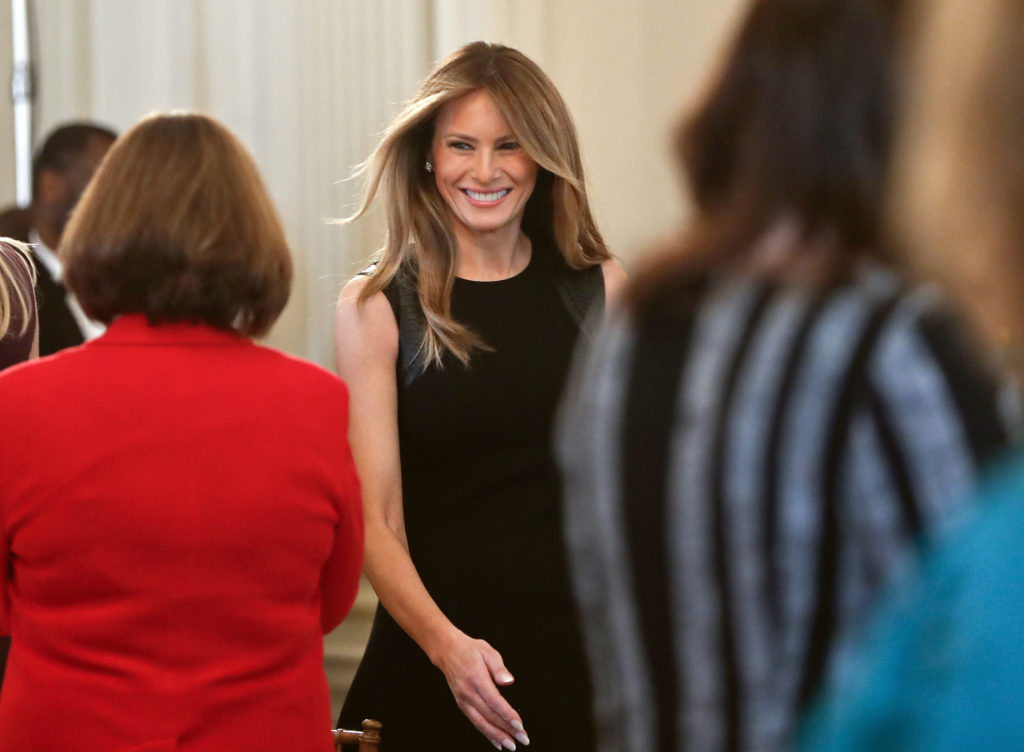Melania Trump begins to embrace new role as first lady

Melania Trump‘s invitation for high-powered women to join her at the White House was about more than the lunch they would eat, or the stated purpose of honoring International Women’s Day. It marked a “coming out,” almost two months into President Donald Trump‘s term, for a first lady described by her husband as a “very private person.” She had spent a couple of weeks hunkered down at the family’s midtown Manhattan penthouse while Trump got down to work in Washington. Now, the former model is taking her first steps into her very public new role Mrs. Trump strode into the State Dining Room for her first solo White House event after an announcer intoned, “Ladies and gentlemen, the first lady of the United States, Melania Trump,” and was greeted by the all-female group of about 50 people, including ambassadors, Cabinet members, at least one U.S. senator and stepdaughter Ivanka Trump. Mrs. Trump asked guests for suggestions on how best to empower women and girls worldwide, possibly foreshadowing women’s empowerment as an issue she would pursue as first lady. Trump said recently that his wife, who turns 47 next month, feels strongly about “women’s difficulties.” “I will work alongside you in ensuring that the gender of one’s birth does not determine one’s treatment in society,” she told guests, according to a tweet by a White House official. The White House allowed a small pool of journalists to watch as guests and the first lady arrived for Wednesday’s lunch, but they were ushered out as Mrs. Trump began to speak. The White House press office promised to distribute text of her prepared remarks after the event, but a transcript has not been released. In recent weeks, Mrs. Trump helped plan their first big White House social event, an annual, black-tie dinner for the nation’s governors. She followed up with a trip the next day to Mount Vernon, George Washington’s estate in Virginia, where she was hosted by the governors’ spouses. The first lady has made other quiet appearances, watching her husband sign legislation and executive orders, and accompanying him to the Capitol for a speech to Congress. She took her counterparts from Japan and Israel on cultural outings and quickly learned the burden of new scrutiny and protocol when she was criticized for not being at the White House to greet the Japanese prime minister’s wife. Instead, Mrs. Trump met the president and Shinzo Abe and his wife, Akie, at Joint Base Andrews in Maryland for an Air Force One flight to Florida. Trump treated Abe to a weekend at Trump’s estate in Palm Beach, Florida. Melania Trump then took Akie Abe to tour a nearby Japanese garden. “We see her physical presence,” said Jean Harris, professor of political science and women’s studies at the University of Scranton in Pennsylvania. All first ladies go through an adjustment period as they figure out how to handle one of the most unforgiving roles in American political life. Unlike many of Mrs. Trump’s predecessors, who were politically experienced through marriage to governors or members of Congress, she is married to a lifelong businessman who never held elective office until he became president. Complicating her White House launch is the couple’s decision for the first lady to continue living at Trump Tower until their 10-year-old son, Barron, finishes the school year. She’s not expected to live full time at the White House for at least several more months, leaving Trump largely on his own and without a traditional source of moral support. Mrs. Trump has also been slow to staff the East Wing of the White House, where the first lady’s office is based. She so far has named only a social secretary and a chief of staff. The president has said he doesn’t want to fill hundreds of government vacancies because they are “unnecessary,” which could include the East Wing. And the slow pace of building her staff could be complicating operations. It’s customary for the White House Visitors Office to close temporarily during a change in administration since political appointees do the work. But this year’s shutdown lasted longer than usual, frustrating members of Congress who are responsible for distributing White House public tour tickets to constituents. Tours resumed earlier this week after a more than six-week pause. Speculation about whether the Trumps would continue the annual Easter Egg Roll on the South Lawn had been mounting until they announced this week that it will be held on April 17. The first lady’s popularity has risen 16 percentage points since the Jan. 20 inauguration, according to recent polling by CNN, climbing to 52 percent, from 36 percent. Kate Andersen Brower, author of “First Women,” said the public sees Mrs. Trump as a calming force and as someone who has embraced being a mother. “She’s really the polar opposite of him,” she said, noting that the first lady barely tweets, unlike her husband’s daily Twitter habit. Mrs. Trump also hadn’t been seen in public for several weeks after the inauguration, whereas the president appears on camera most days of the week. “I think most people find it endearing that she doesn’t crave the spotlight in a way that he clearly does,” Brower said. Harris said the public is giving Mrs. Trump “a little bit of a honeymoon period” but predicted the mood will change if she doesn’t move to the White House. Republished with permission of The Associated Press.
Census data shows great strides for women, but much more left to do
In the past four decades, there has been a number of changes in American society and culture. However, for women in the U.S., some things have stayed much the same, according to Census Bureau data released in advance of National Women’s History Month. National Women’s History Month began in March 1857, when women from New York City factories staged a protest over working conditions. International Women’s Day, first observed in 1909, led to Congress establishing National Women’s History Week, commemorated the second week of March. By 1987, Congress expanded the week-long celebration to a month, celebrated in March. As for women in today’s workforce, numbers show significant gains, while others show much work left to do. By way of sheer numbers, women’s participation in the labor force has increased considerably, from 30.3 million in 1970 to 75.1 million females 16 and older who participated in the civilian labor force in 2013. Women made up 37.97 percent of the 1970 labor force, jumping to 47.4 percent of the civilian labor force in 2013. Particular occupations have also seen a sharp increase in women workers. Census data had shown little participation from women in 1970 as accountants, police officers, lawyers and judges, physicians and surgeons, and pharmacists. By 2006-2010, women made considerable gains in those fields – with particularly strong presence as accountants (60 percent). Of the STEM (science, technology, engineering, and math) fields, 63 percent of social scientists are women, the heaviest representation of women among all. Among other STEM fields, about 14 percent of engineers, 45 percent of mathematicians and statisticians and 47 percent of life scientists were women. On the other hand, growth in certain segments of the workforce has slowed for women. The largest gain in women’s workforce participation occurred between 1970 and 1980, followed by a slowdown. An increase of only 0.4 percentage points occurred in the period leading up to 2006-2010. Compare that growth rate to a peak of 4.3 percentage points in the 1970s. Several occupations are overwhelmingly female. For example, women make up 96.3 percent of dental assistants, 95.9 percent of secretaries and 91.2 percent of registered nurses. Those standings have changed the least in the past 40 years. In 1970, secretaries, bookkeepers, and elementary school teachers were primarily women. In 2006-2010, those women-led occupations were secretaries and administrative assistants, cashiers, and elementary and middle schoolteachers. One explanation is the sheer numbers of jobs available; there are more jobs out there for elementary and middle school teaching positions than (as an example) surgeons. In comparison, the leading jobs for men remain the same as back in 1970: miscellaneous managers, truck drivers, and production supervisors. Four decades later, it is truck drivers, various managers, and freight, stock, and material movers. Researchers say the increase in female participation in the workplace started with the economics of the 1970s, beginning when a single-income household could no longer support a middle-class lifestyle. Gender wage gap remained a major issue in 2014; the Census found that year-round, full-time female workers earned 78¢ in 2013 for every dollar their male counterparts earned. Those numbers are not statistically different from 2012. [Source: U.S. Census Bureau]
Introducing: Alabama Today Women of Influence

As the U.S. Census celebrates March as National Women’s Month, Alabama Today proudly kicks off its “Women of Influence” series. The weekly column will spotlight the women of Alabama who are impacting communities, strengthening families and leading businesses. National Women’s History Month began in 1857, when women from New York City factories staged a protest over working conditions. International Women’s Day, first observed in 1909, led to Congress establishing National Women’s History Week, commemorated the second week of March. By 1987, Congress expanded the week-long celebration to a month. Every year, Congress passes a resolution to honor Women’s History Month, with a proclamation issued by the President. As of December 2013, there are 161 million females in the U.S., compared to 156.1 million males. More than 75.1 million women ages 16 and older participate in the civilian workforce. According to Census estimates, the top four occupations with a majority of women — 80 percent or more are registered nurses; social workers; licensed practical and vocational nurses; and bookkeeping, accounting and auditing clerks. Readers are encouraged to nominate women of influence from around Alabama who are active in business, politics, philanthropy and more at tips@altoday.com.


